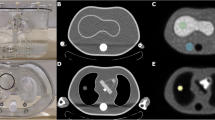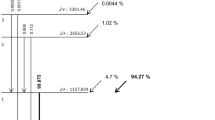Abstract
Introduction
Reliable quantification in positron emission tomography (PET) requires accurate attenuation correction of emission data, which in turn entails accurate determination of the attenuation map (µ-map) of the object under study. One of the main steps involved in CT-based attenuation correction (CTAC) is energy-mapping, or the conversion of linear attenuation coefficients (µ) calculated at the effective CT energy to those corresponding to 511 keV.
Materials and methods
The aim of this study is to compare different energy-mapping techniques including scaling, segmentation, the hybrid method, the bilinear calibration curve technique and the dual-energy approach to generate the µ-maps required for attenuation correction. In addition, our newly proposed method involving a quadratic polynomial calibration curve was also assessed. The µ-maps generated for both phantom and clinical studies were assessed qualitatively and quantitatively. A cylindrical polyethylene phantom containing different concentrations of K2HPO4 in water was scanned and the µ-maps calculated from the corresponding CT images using the above-referenced energy-mapping methods. The CT images of five whole-body data sets acquired on a GE Discovery LS PET/CT scanner were employed to generate µ-maps using different energy-mapping approaches that were compared with the µ-maps generated at 511 keV using 68Ge/68Ga rod sources. In another experiment, the evaluation was performed on PET images of a clinical study corrected for attenuation using µ-maps generated using the above described methods. The evaluation was performed for three different tissue types, namely, soft tissue, lung, and bone.
Results and Discussion
All energy-mapping methods yielded almost similar results for soft tissues. The mean relative differences between scaling, segmentation, hybrid, bilinear, and quadratic polynomial calibration curve methods and the transmission scan serving as reference were 6.60%, 6.56%, 6.60%, 5.96%, and 7.36%, respectively. However, the scaling method produced the largest difference (16%) for bone tissues. For lung tissues, the segmentation method produced the largest difference (14.9%). The results for reconstructed PET images followed a similar trend. For soft tissues, all energy-mapping methods yield results in nearly the same range. However, in bone tissues, the scaling method resulted in considerable bias in the µ-maps and the reconstructed PET images. The segmentation method also produced noticeable bias especially in regions with variable densities such as the lung, since a single µ is assigned to the lungs. Apart from the aforementioned case, despite small differences in the generated µ-maps, the use of different energy-mapping methods does not affect, to a visible or measurable extent, the reconstructed PET images.









Similar content being viewed by others
References
Sanchez-Crespo A, Andreo P, Larsson SA (2004) Positron flight in human tissues and its influence on PET image spatial resolution. Eur J Nucl Med Mol Imaging 31:44–51
Rousset O, Rahmim A, Alavi A, Zaidi H (2007) Partial volume correction strategies in PET. PET Clinics 2:235–249
Zaidi H, Koral KF (2004) Scatter modelling and compensation in emission tomography. Eur J Nucl Med Mol Imaging 31:761–782
Zaidi H, Hasegawa BH (2003) Determination of the attenuation map in emission tomography. J Nucl Med 44:291–315
Osman MM, Cohade C, Nakamoto Y, Wahl RL (2003) Respiratory motion artifacts on PET emission images obtained using CT attenuation correction on PET-CT. Eur J Nucl Med Mol Imaging 30:603–606
Lartizien C, Kinahan PE, Swensson R, Comtat C, Lin M, Villemagne V, et al (2003) Evaluating image reconstruction methods for tumor detection in 3-dimensional whole-body PET oncology imaging. J Nucl Med 44:276–290
Bai C, Kinahan PE, Brasse D, Comtat C, Townsend DW, Meltzer CC, et al (2003) An analytic study of the effects of attenuation on tumor detection in whole-body PET oncology imaging. J Nucl Med 44:1855–1861
Kinahan PE, Hasegawa BH, Beyer T (2003) X-ray-based attenuation correction for positron emission tomography/computed tomography scanners. Semin Nucl Med 33:166–179
Kinahan PE, Townsend DW, Beyer T, Sashin D (1998) Attenuation correction for a combined 3D PET/CT scanner. Med Phys 25:2046–2053
Ay M, Zaidi H (2006) Computed Tomography-based attenuation correction in neurological positron emission tomography: evaluation of the effect of x-ray tube voltage on quantitative analysis. Nucl Med Commun 27:339–346
Mawlawi O, Erasmus JJ, Munden RF, Pan T, Knight AE, Macapinlac HA, et al (2006) Quantifying the effect of IV contrast media on integrated PET/CT: clinical evaluation. AJR Am J Roentgenol 186:308–319
Ahmadian A, Ay MR, Bidgoli JH, Sarkar S, Zaidi H (2008) Correction of oral contrast artifacts in CT-based attenuation correction of PET images using an automated segmentation algorithm. Eur J Nucl Med Mol Imaging 35:1812–1823
Ay M, Zaidi H (2006) Assessment of errors caused by x-ray scatter and use of contrast medium when using CT-based attenuation correction in PET. Eur J Nucl Med Mol Imaging 33:1301–1313
DiFilippo FP, Brunken RC (2005) Do implanted pacemaker leads and ICD leads cause metal-related artifact in cardiac PET/CT? J Nucl Med 46:436–443
Lemmens C, Montandon M-L, Nuyts J, Ratib O, Dupont P, Zaidi H (2008) Impact of metal artefacts due to EEG electrodes in brain PET/CT imaging. Phys Med Biol 53:4417–4429
Bai C, Shao L, Da Silva A, Zhao Z (2003) A generalized model for the conversion from CT numbers to linear attenuation coefficients. IEEE Trans Nucl Sci 50:1510–1515
Beyer T, Kinahan PE, Townsend DW, Sashin D (1994) The use of X-ray CT for attenuation correction of PET data. Proc IEEE Nuclear Science Symposium and Medical Imaging Conference. 30 Oct.-5 Nov., Norfolk, VA, USA, 1573–1577
Burger C, Goerres G, Schoenes S, Buck A, Lonn AHR, Von Schulthess GK (2002) PET attenuation coefficients from CT images: experimental evaluation of the transformation of CT into PET 511-keV attenuation coefficients. Eur J Nucl Med 29:922–927
Guy MJ, Castellano-Smith IA, Flower MA, Flux GD, Ott RJ, Visvikis D (1998) DETECT-dual energy transmission estimation CT-for improved attenuation correction in SPECT and PET. IEEE Trans Nucl Sci 45:1261–1267
Kinahan PE, Alessio AM, Fessler JA (2006) Dual energy CT attenuation correction methods for quantitative assessment of response to cancer therapy with PET/CT imaging. Technol Cancer Res Treat 5:319–327
Shirmohammad M, Ay M, Sarkar S, Ghadiri H, Rahmim A (2008) Comparative assessment of different energy mapping methods for generation of 511 KeV attenuation map from CT images in PET/CT systems: a phantom study. The Fifth IEEE International Symposium on Biomedical Imaging: From Nano to Macro. Paris, France, pp 644–647
Shirmohammad M, Ay M, Rahmim A, Sarkar S, Zaidi H (2008) A novel energy mapping method for attenuation map generation at 511 keV in computed tomography based attenuation correction [abstract]. Eur J Nucl Med Mol Imaging 35:S146
Flohr TG, McCollough CH, Bruder H, Petersilka M, Gruber K, Suss C, et al (2006) First performance evaluation of a dual-source CT (DSCT) system. Eur Radiol 16:256–268
Greess H, Lutze J, Nomayr A, Wolf H, Hothorn T, Kalender WA, et al (2004) Dose reduction in subsecond multislice spiral CT examination of children by online tube current modulation. Eur Radiol 14:995–999
Wang J, Li T, Lu H, Liang Z (2006) Noise reduction for low-dose single-slice helical CT sinograms. IEEE Trans Nucl Sci 53:1230–1237
Berger MJ, Hubbell JH, Seltzer SM, Chang J, Coursey JS, Sukumar R, et al (1998) XCOM: photon cross sections database. Report NBSIR 87-3597. Gaithersburg: Ionizing Radiation Division, Physics Laboratory, National Institute of Standards and Technology, Gaithersburg, MD 20899. Available at http://physics.nist.gov/PhysRefData/Xcom/Text/XCOM.html
Rahmim A, Tang J, Lodge MA, Lashkari S, Ay MR, Lautamaki R, et al (2008) Analytic system matrix resolution modeling in PET: an application to Rb-82 cardiac imaging. Phys Med Biol 53:5947–5965
Robinson PJ, Kreel L (1979) Pulmonary tissue attenuation with computed tomography: comparison of inspiration and expiration scans. J Comput Assist Tomogr 3:740–748
Zaidi H (2007) Is MRI-guided attenuation correction a viable option for dual-modality PET/MR imaging? Radiology 244:639–642
Nahmias C, Lemmens C, Faul D, Carlson E, Long M, Blodgett T, et al (2008) Does reducing CT artifacts from dental implants influence the PET interpretation in PET/CT studies of oral cancer and head and neck cancer? J Nucl Med 49:1047–1052
Acknowledgments
This work was supported by the Research Center for Science and Technology in Medicine, Tehran University of Medical Sciences under grant No. 86/202. HZ acknowledges the support of the Swiss National Science Foundation under grant No. 31003A-125246.
Author information
Authors and Affiliations
Corresponding author
Rights and permissions
About this article
Cite this article
Ay, M.R., Shirmohammad, M., Sarkar, S. et al. Comparative Assessment of Energy-Mapping Approaches in CT-Based Attenuation Correction for PET. Mol Imaging Biol 13, 187–198 (2011). https://doi.org/10.1007/s11307-010-0303-3
Published:
Issue Date:
DOI: https://doi.org/10.1007/s11307-010-0303-3




